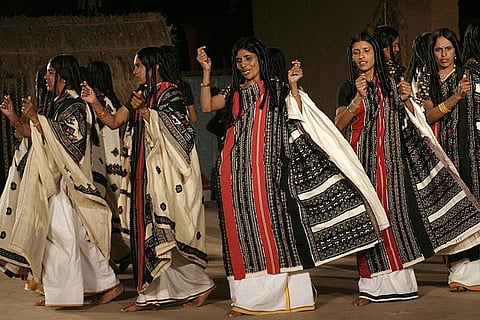
- Home
- न्यूजग्राम
- India
- World
- Politics
- Entertainment
- Culture
- Lifestyle
- Economy
- Sports
- Sp. Coverage
- Misc.
- NewsGram Exclusive
- Jobs / Internships

By- Renata Nathania
The Nilgiri hills of the Western Ghats are home to many unique tribes, and are famously known for their botanical value. Ooty (Ootacamund, or Udhagamangalam), a quaint hill station in this region that is visited all year round, is reputed for its tea, essential oils, and chocolates. The Nilgiris (Blue Mountains) are known for the blue tinge that they give off every twelve years when the kurunji flower blooms all over the hills. The Nilgiris are also famous for the embroidery and art of the Todas, one of the three prominent tribes who live in these hills.
Initially a pastoral tribe, who were responsible for herding a unique species of water buffalo, the Todas were known as an indigenous people who lived in round huts, called mundhs. As time passed, and the grasslands were taken over to build reservoirs, hydel plants, and villages, the men took to becoming daily wagers to keep up the economy of their tribe. During this time, the women stayed at home and began to embroider black and crimson threads according to patterns recognised by their tribes.
The Todas are recognised by the artificial ringlets the women wore in their hair, and the elaborate tattoos they etched all over their bodies. Their arms, legs, and faces are drawn in with dark blue geometrical patterns. This is achieved by making cuts on the body, and inserting soot under the skin. This usually gets infected, after which it leaves a deep blue colour. The tattoos serve as an identification from other local tribes. Within each tribe, the marks also symbolise protection from evil spirits. Even today, in many parts of India, the indigenous people mark their bodies with tribal identification patterns. This practice began, to protect their women from the neighbouring tribes, but over time, it became a cultural aspect.
With the influx of tourists to Ooty, the Todas have shifted away from their traditional way of living. wikimedia
Toda women began to transplant their tattoo designs onto cotton shawls. This craft is known as Poothukuli. The base fabric is always a white cotton shawl, spanning nine yards, which they traded for from other weaving communities. On this, intricate patterns are embroidered in black and crimson thread. The colours are symbolic to the tribe's spiritual ideology. Black represents the netherworld, red represents the earth, and white represents heavenly bodies. The embroidery follows a pattern of three stripes, one in each colour, with smaller details that represent flowers, birds, snakes, peacocks, rabbits, the moon, the sun, and the stars. The local name of the craft is Pugur, which means flower. For the Todas, the pasture, and water bodies are divine, and this is reflected in the patterns they put together.
With the influx of tourists to Ooty, the Todas have shifted away from their traditional way of living. They still follow the architecture of rounded huts, but have now adopted concrete structures instead of natural fibres. Their temple structure is also unchanged, but concretised. There are some families who have not changed the structure of their buildings, but these houses are hidden away deep in the forests. The practice of planting eucalyptus trees all over the periphery of the villages has aided in hiding away the Todas from urban civilisation. Their villages are accessible only through the Upper Bazaar of Ooty, where they source their fabric from, and tourists are generally not allowed to visit.
Traditional Toda mundhwikimedia
The Poothukuli, however, has become a universally accepted craft that the Toda women are proud of. They still sport tattoos all over their body, and still prefer to stick to their traditional designs despite NGOs being set up to try and train the women to adopt newer styles of weaving and embroidery. The women believe that these designs are not culturally appropriate, and outside their belief system. This is one of the main reasons they keep themselves away from the outside world.
